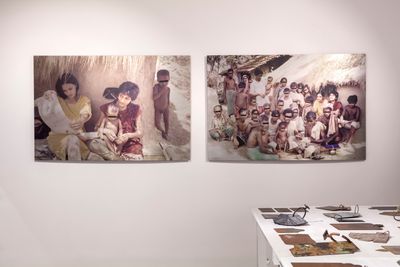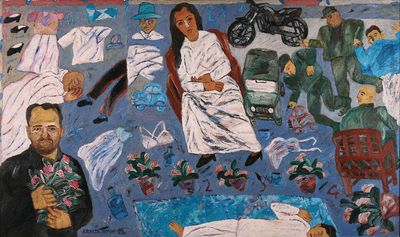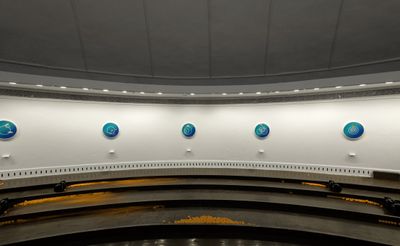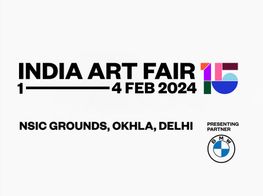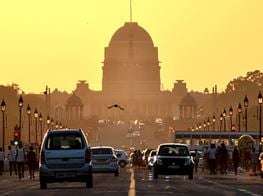India Art Fair 2019: Exhibitions to See
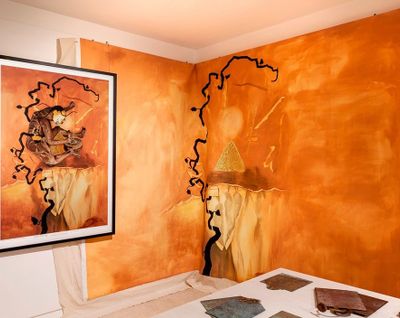
Exhibition view: Pushpamala N: The Body Politic, Nature Morte, New Delhi (11 January–9 February 2019). Courtesy Nature Morte.
India Art Fair runs from 31 January to 3 February 2019, with IAF Director Jagdip Jagpal highlighting the inclusion of talks, walk-throughs, screenings, live events, and performances, including Word and Hopes, Yasmin Jahan Nupur's six-hour performance that interrogates the boundaries between spectator and performer. A series of seven collector's masterclasses will also take place, with advice on buying at auction delivered by head of sales for South Asian Modern + Contemporary Art at Christie's, Nishad Avari, on 3 February. Supported by curator and researcher Sitara Chowfla, this edition will be more focused and better integrated with parallel exhibitions across the city. Here is a selection of shows to see in and around New Delhi during the fair.
Tayeba Begum Lipi: Vanity Fair
Shrine Empire Gallery, D-395, Dron Marg, Block D, Defence Colony, 110049
28 January–2 March 2019
Bangladeshi artist Tayeba Begum Lipi's practice is rooted in subverting patriarchal structures and addressing the voice of marginal communities through art and activism, most pronounced in sculptural everyday objects or women's wear fashioned from razor blades. Her solo at Shrine Empire Gallery expands on this background by reimagining the gallery space as a shop, complete with slogan t-shirts for sale and a fitting room—a wry commentary on vanity in the media, and a critique on cultural production, market influence, and power-driven narcissism. Curated by Anushka Rajendran, the show also presents drawings, sculptures, and videos that interrogate how acts of resistance and movements of defiance are commodified by the very neoliberal systems that facilitate their mobilisation.
Also on view is a filmed conversation with Naeem Mohaiemen, which took place in December 2018, in which the artist contextualises her practice and reflects on her instrumental role in facilitating a contemporary art scene in Bangladesh. The conversati0n also reflects on the current situation in Bangladesh, recently observed in the government's harsh measures against student protests in August 2018, and the continuous stifling of freedom of speech.
As part of India Art Fair's Forum sector, Lipi will present a talk, 'What I Did Last Summer', on 1 February 2019, from 4:30pm to 5:15 pm.
Pushpamala N: The Body Politic
Nature Morte, A-1, Block A, Neeti Bagh, 110049
11 January–9 February 9, 2019
Pushpamala N's fourth solo show at Nature Morte, The Body Politic, is composed of photographs, videos, and sculptures drawn from series produced by the artist since 1985, which reflect ongoing research into the idea of the nation state. The exhibition's title likens social, political, or religious structures to a biological entity, with Pushpamala N placing herself centrally in her images, shifting from one avatar to another with each work. Feminist, seductive, and political, the artist draws from classical Indian dramaturgy and popular cinema, producing elaborate sets with costumes, props, and painted backdrops to stage her images. The series 'Mother India' (2005–ongoing), for example, includes Kali (after 1908 Calcutta Art Studio Print) (2014), an inkjet print of the artist as the Hindu goddess Kali, and Kichaka-Sairandhri (after 1890 oil painting by Raja Varma) (2013), a print made after a painting by Varma, which is hung over a painted backdrop.
Included in the show is a 'pseudo archive' of sculptural objects, titled Transcripts (2018), inspired by a vitrine at Bangalore's archaeological museum, containing records of land grants preserved in copper plates. Also displayed are photographs taken during an art school trip to document folk artists in Bengal, with the artist identifying in these images a gaze that is not unlike that of a colonial ethnographer. Titled The Ethnographers? (2017), black bands cover the villagers' eyes, protecting their identities and alluding to the misgivings of privilege.
This Must be True
Khoj Studios, Khoj International Artists' Association, S-17, Khirkee Extension, 110017
28 January–28 February 2019
This group exhibition is hinged on interpretations of truth, and features works by Ala Younis, Bani Abidi, Lawrence Abu Hamdan, Pallavi Paul, Rafael Lozano-Hemmer, Sahil Naik, SUPERFLEX, Susan Schuppli, Zuleikha Chaudhari + KHOJ.
Curated by three members of Khoj's curatorial team, Mario D'Souza, Mila Samdub, and Radha Mahendru, the exhibition gathers a series of documentary, testimonial, and improvised sound and video recordings, as well as installations and objects that question the criteria and means employed by both aesthetics and law in the production of truth. These include a filmed recording of a staged hearing—the theatrical performance piece Landscape as Evidence: Artist as Witness, conceived by Khoj and Zuleikha Chaudhari in collaboration with Anand Grover, and performed at the Constitution Club of India on 7 April 2017. The performance flirts with the idea of art as evidence in a court of law, and serves as the point of departure for the show—it is one way the exhibition curiously toys with contemporary concerns over surveillance, big data, digital platforms, and artificial intelligence.
Astha Butail: In the Absence of Writing
Gujral Foundation, 24 Jor Bagh Colony Rd, Jor Bagh, 110003
1–28 February 2019
In the Absence of Writing is the project that Astha Butail proposed and created as part of the BMW Art Journey Award 2017–2018, and is the point of departure for this solo exhibition of the same name. Butail's year-long research into how collective memories and living traditions are kept among communities focused on the teachings and poetry of Zoroastrian Avesta (the primary collection of religious texts belonging to the Zoroastrian faith), the Jewish Oral Torah (the laws and tenets that were not collated into the Oral Torah or the Book of Moses), and Indian Vedic philosophy (India's ancient scriptures that constitute the oldest compilations of Sanskrit literature). Butail travelled to sites of learning or faith, across India, the U.K., Iran, and Israel, where she met scholars, religious teachers, and students to observe how knowledge is transmitted and preserved. In one intervention, she invited students to chant inside a mobile tent made of muslin and gauze—a quasi-ritual emphasising the delicate preservation of the 'word' in traditions of oral learning, and the various slippages between memory and its understanding.
The artist's journey uncovered the manner in which knowledge is not only preserved, but also performed and experienced—a feature she extends and explores in this show, which will present works produced for the BMW Art Journey Award, alongside new site-specific works commissioned by The Gujral Foundation. Curated by Reha Sodhi, the show is conceived as an experiential and interactive series of discoveries with sound, sculptures, videos, and installations.
Deeper Within its Silence | form and unbecoming
Devi Art Foundation, A-195, Okhla Industrial Area Phase 1, 110020
28 January–4 March 2019
This exciting new group exhibition featured works by Alwar Balasubramaniam, Ayesha Sultana, Avinash Veeraraghavan, Ehsan-ul Haq, Ferwa Ibrahim, Hemali Bhuta, Hetain Patel, Huria Khan, Idris Khan, Iqra Tanveer, Manish Nai, Mithu Sen, Noor Ali Chagani, Ranjini Shettar, Rina Banerjee, Rohini Devasher, Sakshi Gupta, Sheela Gowda, Shreyas Karle, Unum Babar, Vivan Sundaram, and Zarina Hashmi. It explores perspectives of the metaphysical and spiritual, with works on show culled from the collection of the Devi Art Foundation. The Foundation was established by Lekha and Anupam Poddar in 2007, and consists of artworks in media ranging from painting, sculpture, interactive installation, video, and photography. Representations from India's folk and tribal art forms—along with art from Pakistan, Sri Lanka, Iran, Bangladesh, and Tibet—form the core of the collection.
Curator Sumakshi Singh, who is also an artist, employs her own interest in quantum physics and her practice of meditation to ask if the immaterial could possibly address the material, employing poetry, light, shadow, and object traces in an exploration into the energies that pulsate in unexplained space. Encompassing the mutable and the vibratory, a series of 26 artistic inquiries question and explore the appearance and understanding of form.
Arpita Singh: A Retrospective
Kiran Nadar Museum of Art, No. 145, DLF South Court Mall, Shaheed Pankaj Juyal Marg, Saket District Centre, Saket, 110017
30 January–30 June 2019
Curated by director and chief curator of the Kiran Nadar Museum of Art (KNMA), Roobina Karode, an art historian who has been with the institution since its inception in 2010, this show comprises over 100 works spanning six decades of Arpita Singh's narrative work, including drawings, watercolours on paper, and oil on canvas paintings. Singh joins a league of India's seminal artists who have been honoured with retrospective exhibits at the KNMA each year with exhibitions that open in January.
With works from the collection as well as loans from other public and private collections, the exhibition will delve deep into this seminal modernist painter's exploration of gender roles in India, as well as her critical observations on events ranging from the historic to the mundane, sometimes in the same frame. Emotive and discursive, the retrospective presents some of Singh's most important works, like My Mother (1993) and In Search of Sita (2014), which is based on the episode of Sita's abduction from the Indian epic Ramayana—a piece made specifically for Kiran Nadar.
Thukral and Tagra: LULLAMENTS
STIR Gallery (Vis-à-Vis), DLF Chattarpur Farms, 2, North Dr, Chhattarpur, 110074
2–25 February 2019
Lullaments is a single kinetic sculpture where ping-pong balls are whizzed to the left or the right by fans on either side of a track laid on the floor. The low repetitive hum the installation creates is intended to affect anxiety or pleasure, depending on the listener's frame of mind.
The show is an extension of two projects by this artist duo. The first is the 2015 Games People Play, staged at Mumbai's Dr. Bhau Daji Lad Museum, which engaged with the museum's collection of traditional games, like ganjifa (a traditional card game), or kabbadi (a contact team sport). The duo reimagined the museum as a gaming arena in order to explore the strategic, cultural, and psychological dimensions of play, categorising games into the physical, mental and spiritual, thus highlighting the overlaps between sport, exercise, and everyday ritual. In the work The Game of Table Tennis, the table of this British parlour game is shaped as the map of the seven islands that make up the city of Mumbai; the ball being tossed back and forth a reminder of the rules to which the land and people adapted.
The second project extended in this current show is Play Pray, which was shown at New Delhi's Bikaner House in 2017, and hinges on the narration of the ten incarnations of the Hindu God Vishnu through sport in order to unravel the meditative aspects of play. Told through the vocabulary of ping-pong, where the individual is imagined to be the ball and the exhibition space is imagined as time, each to and fro in space becomes an episode of life.—[O]

